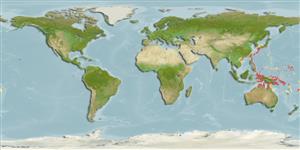Common names from other countries
Klassifizierung / Names
Namen | Synonyme | Catalog of Fishes(Gattung, Arten) | ITIS | CoL | WoRMS | Cloffa
>
Gobiiformes (Gobies) >
Gobiidae (Gobies) > Gobiinae
Etymology: Eviota: No etymology given, suggested by Christopher Scharpt: from Latin 'eu' for 'true' and 'iota' for anything very small, in combination 'truly very small' referring to it as being the smallest vertebrate at the time it has benn described by Jenkins (thus, making the suggestion by Scharpt plausible.; occasa: Name from Latin 'occaus' meaning sunset, referring to the distinctive yellow-orange broad wedge-shaped bar at the caudal-fin base on a red body; noun in apposition..
Environment: milieu / climate zone / depth range / distribution range
Ökologie
seewasser benthopelagisch; tiefenbereich 14 - 20 m (Ref. 94952). Subtropical
Western Pacific: Palau and Japan.
Size / Gewicht / Alter
Maturity: Lm ? range ? - ? cm
Max length : 1.0 cm SL Männchen/unbestimmt; (Ref. 94952)
Kurzbeschreibung
Morphologie | Morphometrie
Rückenflossenstacheln (insgesamt): 7; Rückenflossenweichstrahlen (insgesamt): 8; Afterflossenstacheln 1; Afterflossenweichstrahlen: 8. This species is distinguished by the following characters: lacks all cephalic sensory-canal pores; dorsal/anal fin-ray formula 8/8; some pectoral-fin rays are branched; rudimentary or no fifth pelvic-fin ray; 5 branches in fourth pelvic-fin ray; D1 crossed by two dark bands separated by a diagonal light band, a distinct dark spot on caudal peduncle anterior to caudal fin, followed by a pale bar and a yellow-orange broad wedge-shaped bar at caudal-fin base (Ref. 94952).
Life cycle and mating behavior
Geschlechtsreife | Fortpflanzung | Ablaichen | Eier | Fecundity | Larven
Greenfield, D.W., R. Winterbottom and T. Suzuki, 2014. Eviota occasa, a new species of dwarfgoby from Palau and the Ryukyu Islands, Japan. (Teleostei: Gobiidae). J. Ocean Sci. Found. 10:11-19. (Ref. 94952)
IUCN Rote Liste Status (Ref. 130435)
CITES (Ref. 128078)
Not Evaluated
Bedrohung für Menschen
Harmless
Nutzung durch Menschen
Mehr Information
NamenSynonymeMetabolismusRäuberÖkotoxikologieFortpflanzungGeschlechtsreifeAblaichenFecundityEierEientwicklung
Alter/GrößeWachstumLänge-GewichtLänge-LängeLängenhäufigkeitenMorphometrieMorphologieLarvenLarven Pop.Dyn.RekrutierungDichte
ReferenzenAquakulturAquakultur ProfilZuchtlinienGenetikElectrophoresesVererbbarkeitKrankheitenVerarbeitungMass conversion
PartnerBilderStamps, Coins Misc.LauteCiguateraGeschwindigkeitSchwimmstilKiemenoberflächeOtolithsGehirngrößeSehfähigkeit
Tools
Zusatzinformationen
Download XML
Internet Quellen
Estimates based on models
Preferred temperature (Ref.
115969): 24.2 - 29.4, mean 28.8 (based on 556 cells).
Phylogenetic diversity index (Ref.
82804): PD
50 = 0.5000 [Uniqueness, from 0.5 = low to 2.0 = high].
Bayesian length-weight: a=0.00708 (0.00333 - 0.01504), b=3.09 (2.92 - 3.26), in cm Total Length, based on LWR estimates for this (Sub)family-body shape (Ref.
93245).
Trophic level (Ref.
69278): 2.9 ±0.3 se; based on size and trophs of closest relatives
Widerstandsfähigkeit (Ref.
120179): hoch, Verdopplung der Population dauert weniger als 15 Monate. (Preliminary K or Fecundity.).
Fishing Vulnerability (Ref.
59153): Low vulnerability (10 of 100).
